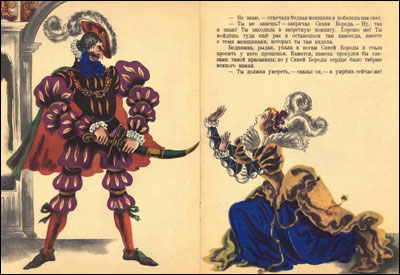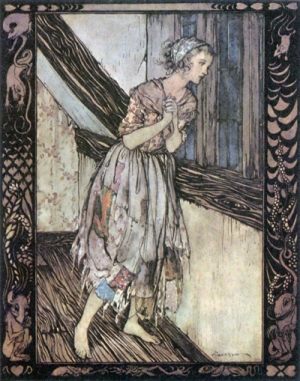 Beneath its prim and proper exterior, the Victorian period was a fascinating, dark time. As far as fairy tale history goes, any version of a tale that people mistakenly call the "original" or "classic" was probably created and enforced during this time period. Not only did the morality of the Grimms shape how they edited their volumes of tales, but countless other translators, editors, and illustrators in this period contributed to what we now think of as the definitive fairy tale genre.
Beneath its prim and proper exterior, the Victorian period was a fascinating, dark time. As far as fairy tale history goes, any version of a tale that people mistakenly call the "original" or "classic" was probably created and enforced during this time period. Not only did the morality of the Grimms shape how they edited their volumes of tales, but countless other translators, editors, and illustrators in this period contributed to what we now think of as the definitive fairy tale genre.It's getting pretty trendy today to point back to the grim and gruesome details of the fairy tales that came from this time, partly for shock value and partly to legitimize the idea that fairy tales are not just simplistic stories for children. The amount of violence found in the tales can be disturbing for modern audiences.
Illustration-H.J. Ford, "The Girl Without Hands"
Our modern consumption of murder mysteries and violent media as arguably a much better alternative to what this replaced-through the Victorian period, criminals were often publicly executed for sometimes minor infractions of the law. Going to see a hanging was entertainment for the poor people-executions drew crowds who watched the events unfold like they would watch a play on the stage.
Image of the last public hanging in England
May 26, 1868
Yet in life, as in fairy tales, this exposure to death and violence was seen as excusable because it also provided an opportunity for moralizing. It was very common during the Victorian period to add a "moral" at the end of fairy tales aimed at teaching children how to behave properly, and the same went for the way the newspapers covered famous criminal cases. Broadsides, or a cheap, one-sided newspaper, would come out with a "confession" from the criminal (printed before the death actually happened,) including a remorseful insight into the now-realized futility of a life of crime. In murder cases, people were arrested and charged, often on very little evidence. This was partly due to a police system in its infancy and in a time before science and technology provided the ways we now catch criminals, but also to pacify the crowds into thinking they were safe and to give the impression that there was a happy ending, because the criminal was done away with.
Therein lies the paradox of consuming murder as entertainment-we are pleased as we are horrified, and comforted as we are disgusted. When I want a light, easy read I turn to Agatha Christie (even though I also get really depressed watching the news). The world of mystery, despite the necessary violence, is actually one of the most predictable and satisfying. There is a clear villain and a clear happy ending in which the criminal is caught and brought to justice.
George Melies' "Bluebeard", 1901
This goes a long way to explain the fact that Bluebeard was wildly popular in the Victorian period and even considered a suitable source for children's entertainment. The awful image of the bloody chamber was exciting as it was dreadful, and it was all okay as long as it taught children a very important lesson (in fact, the bloody chamber in Bluebeard is very similar to the Chamber of Horrors in Madame Tussaud's waxworks museum, very popular in the Victorian era, where bodies and scenes of famous murderers and their victims are on display. A google search will get you even more disturbing images than this one of the heads of French royalty as they were, just after the guillotine).
And of course, one of the greatest mysteries of fairy tale history is how so many people in the Victorian period could have actually interpreted the Bluebeard tale as a cautionary story against women's curiosity and not the obviously more evil serial killing husband. Yet these quotes really shed light on the issue: at the trial of Maria Manning, a famous 1849 murder case, her husband's barrister said "History teaches us that the female is capable of reaching higher in point of virtue than the male, but that when once she gives way to vice, she sinks far lower than our sex." Somehow their unfair expectations of females having the ability to achieve near "perfection" (more like, submission) was also used to unfairly condemn. Even though Maria and her husband were both found guilty of murdering Maria's lover, a popular ballad sung and sold at the execution (it really was an entertainment source!) goes "Old and young, pray take a warning/Females, lead a virtuous life/Think upon the fateful morning/Frederick Manning and his wife." Note that females are singled out for the warning despite their joint guilt.
Russian Illustrated Children's Book (anybody know the artist?)
Yet the gender bias was so strong that some women were able to use this idea to their advantage-female murderers who are most likely guilty were able to escape sentencing simply because the public could not believe that they were actually guilty, such as Florence Bravo and Madeleine Smith. Though the evidence all pointed to them having murdered their husbands, the public couldn't accept that a young, beautiful, proper woman could have done such an "unfeminine" thing. Many people thought it was unseemly for a woman to even take interest in their cases, yet the world of murder was actually somewhat empowering. Women caught in oppressive marriages could actually speak out for themselves-at her trial Florence told reporters that her abusive husband "had no right to treat me in such a way" and was unpunished for poisoning him. Detective fiction as a genre was pretty proto feminist at its beginning, featuring strong and clever females.
One more fairy tale connection-in the famous Road Hill House case, older sister Constance eventually confessed to slashing her brother's throat in the middle of the night. The reason was most likely that the little boy was her stepbrother, and much like Cinderella, Constance and her full brother were mistreated, while her stepmother's children were given preferential treatment. She had previously run away from home and told her friends that she was treated cruelly. Once again she was not initially convicted, partially because of prejudice (servants were suspected first) and delicate Victorian sensibilities (a key piece of evidence, her nightgown being missing and bloodied, was not spoken of because it was inappropriate to talk about what a woman wore to bed). Yet years later she confessed and gave some closure to an unsolved case.
Arthur Rackham-Cinderella
*Source: The Art of the English Murder, by Lucy Worsley. Not directly fairy tale related, but a fascinating read that I highly recommend! I couldn't put it down!






Hey, I didn't know George Melies did a Bluebeard film! Of course, he did so many, why not? I agree, we enjoy murder mysteries because there's a resolution at the end, murderer punished, happy ending. And also because it's a puzzle to solve. Certainly preferred to the real thing! But children are bloodthirsty little things, bless them, and I suspect the gruesome fairytales only result in a happy, "Ooh, yuk! Gross!"
ReplyDeleteThere are lots of reasons, as you say, that murder fiction is so popular. Part of what the book was talking about is how people-children and adults alike-tend to be drawn towards real murders too, following the cases, going to museums all about murders, etc. Certainly some people more than others but there's a universal fascination with murder and a desire to see justice done.
DeleteI do often wonder about children and how they perceive violence...when it comes to Looney Toon cartoons, like I mentioned in a recent post, they're so obviously fake and funny it's hard to take them seriously. Oral fairy tales don't elicit quite the same response as seeing something visually on tv, and then it all depends on how its handled. Even with famous fairy tale scenes, like the Bloody Chamber-it's shocking if you've never heard of it before, but if it's something you grew up with you wouldn't think about it as much, sort of like how we're used to the scene where Gretel pushes the witch in the oven. We aren't very bothered by it, it's considered part of childhood, yet it would be an extremely painful way to die and could theoretically give children bad ideas about other things to try and push in an oven. I could see, in a civilization that wasn't familiar with that fairy tale, them looking at us and being horrified we expose our children to it
This is a really good blog post of yours.
ReplyDeleteIt makes me so thankful that Jane Eyre was published when it was. Some didn't think a woman was capable of writing it. Also it carries some fairy tale themes.
Yes!! The more I learn about Victorian culture, the more impressed I am with those early proto-feminists. The Bronte sisters are heroes!!
Delete